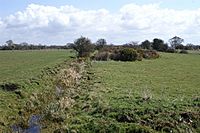Catcott, Edington and Chilton Moors facts for kids
| Site of Special Scientific Interest | |

Edington Heath
|
|
| Area of Search | Somerset |
|---|---|
| Coordinates | 51°10′26″N 2°52′26″W / 51.17397°N 2.87395°W |
| Interest | Biological |
| Area | 1,083 hectares (10.83 km2; 4.18 sq mi) |
| Notification | 1967 |
Catcott, Edington and Chilton Moors SSSI is a special place in Somerset, England. It covers a huge area of 1083 hectares (that's about 2676 acres!). This site is protected because it's a very important home for many different plants and animals. It became a protected area in 1967.
This special site is located near the villages of Edington and Catcott.
Contents
Protecting Nature in the Brue Valley
This area is part of a bigger plan called the Brue Valley Living Landscape project. This project started in 2009. Its main goal is to help nature thrive.
What the Project Does
The project works to restore, recreate, and connect different natural areas. This helps wildlife grow and survive, even with climate change. It also makes sure that farmers and landowners can still use their land. This project is one of many similar efforts across the UK.
Exploring Catcott Moors
The Catcott, Edington and Chilton Moors SSSI is a low-lying area. It is south of the River Brue. This land often floods, which is important for its unique wildlife.
How the Site is Managed
The Somerset Wildlife Trust helps manage this special place. It includes several important areas:
- Catcott Lows National Nature Reserve
- Catcott Heath
- Catcott North
Amazing Plants and Animals
This site has many different types of soil. This, along with how the land is managed, helps a wide variety of plants and animals live here.
Wonderful Wildflowers
You can find many beautiful plants in the meadows. Some common ones include:
- Meadow thistle (Cirsium dissectum)
- Meadow rue (Thalictrum flavum)
- Southern marsh-orchid (Dactylorhiza praetermissa)
In the wetter parts, you might see rushes and marsh marigold (Caltha palustris). Catcott Heath is famous for its rare plants. These include:
- Marsh pea (Lathyrus palustris)
- Milk-parsley (Peucedanum palustre)
- Marsh fern (Thelypteris palustris)
The water channels and ditches are also full of life. Over 127 different water and bankside plant species have been found here.
Incredible Insects
The water channels are home to many insects. These include:
- Water beetles like Haliplus mucronatus and Hydrophilus piceus
- The rare soldier fly, called the flecked general (Stratiomys singularior)
You can also see many beautiful dragonflies and damselflies flying around.
Fascinating Wildlife
All these plants and insects support many bird species. Look out for:
- Golden plover (Pluvialis apricaria)
- Lapwing (Vanellus vanellus)
- Snipe (Gallinago gallinago)
- Dunlin (Calidris alpina)
Other animals living here include:
- The otter (Lutra lutra)
- Grass snake (Natrix natrix)
- Common frog (Rana temporaria)

